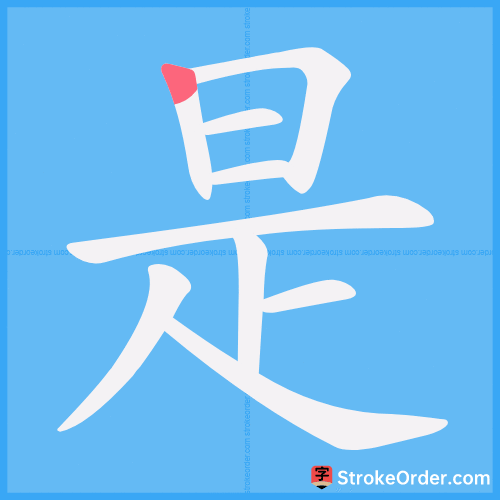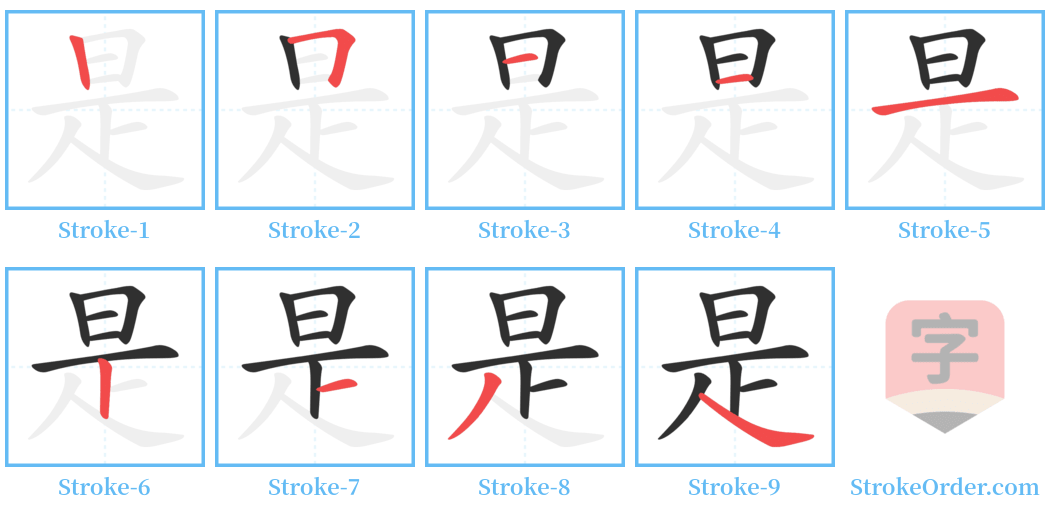是 Stroke Order
Animated Stroke Order of 是

Stroke Order Diagrams for 是

Step-by-Step Handwriting Guide for 是

Learn to Write Chinese Characters with Video Tutorials
Watch the video of writing the Chinese character "是", learn the correct stroke order (笔顺) of the character "是", and master the standard way of writing the character "是".
Free Printable Handwriting Practice with Stroke Order: 是
Printable Writing Practice Worksheet of "是" in Portrait Orientation (Tian Zi Ge)

Printable Writing Practice Worksheet of "是" in Landscape Orientation (Tian Zi Ge)

Information of 是
Pinyin
shì
Radical
日
Strokes
9 strokes
Usage
★★★★★
Definition
is / are / am / yes / to be
是 [shì]
1. Indicates explanation or classification: He is a worker. The author of "The True Story of Ah Q" is Lu Xun.
2. Indicates existence: Covered in sweat.
3. Indicates acknowledgment, then transitions to the main point, containing the meaning of "although": The poem is good poetry, but it is too long.
4. Indicates suitability: The time to come is right.
5. Indicates any: All are accepted. He is willing to do any job.
6. Used in interrogative sentences: Has he left?
7. Intensifies the tone, meaning "indeed" or "truly": The weather is cold.
8. Right, reasonable, in contrast to "not": Yes, it's true. What he said is correct. Facts seek correctness.
9. Considered correct: It is ancient, not modern. Each follows his own way. Deeply believed in his words.
10. Indicates agreement or consent (often just saying "yes"): Yes, I will go.
11. This, that: This day. If this can be tolerated, what else cannot. Everywhere.
12. A particle that moves the object of an action to the front, indicating an emphasis on a single action: Only you ask. Only pursue profits.
13. A surname.
形 (Form)
- 本义: Right; not slanted.
- 造字法: Pictophonetic. The small seal script form represents "sun" and "right".
1. Same as the original meaning (right).
2. Correct.
3. A summarizing term. Any or every.
代 (Pronoun)
1. This, that.
动 (Verb)
1. Agree; consider correct; affirm.
2. Correct.
3. Obey; view as law.
4. Copula indicating a positive judgment.
5. Indicates two things are the same, or the latter explains the former.
6. Indicates that the subject of the statement belongs to the situation mentioned after "is."
7. Indicates that several matters discussed are unrelated.
8. Indicates existence (be; exist).
9. Indicates concession (be..., but).
10. Indicates suitability (be suitable).
11. Attempt; used interchangeably with "试".
12. Like; resemble.
副 (Adverb)
1. Indicates affirmation (certainly; really).
2. Can be omitted when "是" is not stressed, indicating general affirmation (just).
3. Acts as a virtual word to express agreement when responding to questions, commands, or requests (yes).
4. Very; extremely.
5. Indicates concession, implying "although".
6. The second clause often includes words like "but", "however", or "just".
7. Implies "although"; used in transitional phrases.
8. Indicates reason or purpose. "是" can be followed by "because, due to".
9. Format for choice questions: "or... or...?" "Is it... or...?" "... or...?" "Is it... is it...?"
10. Or.
11. When answering choice questions, repeat part of the question, typically without using "是".
12. Sometimes a complete "是" sentence is used for responses.
13. Answers may sometimes exceed the scope of the question.
名 (Noun)
1. Business, profession, or government affairs, including duties.
2. A surname.
助 (Auxiliary)
Helps bring the object forward.
(emphasizes that sth is precisely or exactly as stated) / precisely / exactly / even / if / just like / in the same way as
(emphasizes that sth is precisely or exactly as stated) / precisely / exactly / even / if / just like / in the same way as
Input Method for 是
Pinyin
shi4
Wubi
jghu
Cangjie
amyo
Zhengma
kaii
Four Corner
60801
Unicode
U+662f
Same Pronunciation Characters